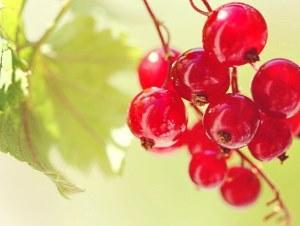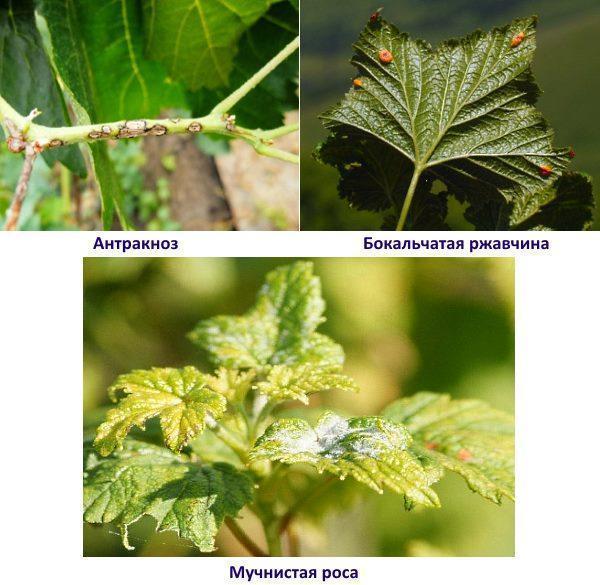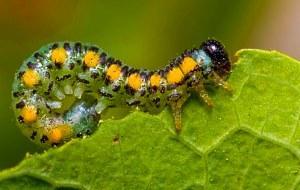The most common currant diseases and how to treat them
 The currant bush does not seem tender and unprotected. It easily tolerates the cold of winter, temperature drops, waterlogging and drought. However, all this does not remain without consequences. Here is a list of the main problems of this plant, currant diseases in the photo look quite convincing:
The currant bush does not seem tender and unprotected. It easily tolerates the cold of winter, temperature drops, waterlogging and drought. However, all this does not remain without consequences. Here is a list of the main problems of this plant, currant diseases in the photo look quite convincing:
- Anthracnose... Signs: small brown spots with tubercles appear on the leaves. They gradually grow, spreading throughout the plant, and the bush dies. Promotes an increase in the focus of the disease and moisture: rain or fog.
- White spot, septoria... The leaves turn white, and small dark spots appear on them, fungal spores. It happens that signs of this disease can be noticed on the fruits. Black currant is more often exposed.
- Goblet rust... This disease is characterized by the appearance of yellow-orange pads that spread to the leaves and flowers of the bush. It is believed that black currants are more susceptible to this disease.
- Powdery mildew... A white bloom appears on young leaves, like a thin cobweb. It mainly affects red currants.
- Spheroteka (another type of powdery mildew, American)... Can affect the whole plant: young leaves and shoots, berries and ovaries. A thin white coating appears, which thickens over time. The leaves become deformed and die off.
- Reverse (terry)... The plant is completely affected, changes in the shape and color of leaves and flowers are noticeable. The flowers dry up, but do not fall off for a long time. Fruit is completely absent. It is mainly black currant that suffers from this disease.
- Striped mosaic... Where veins pass on the leaf, duplication of their pattern appears in yellow or orange.

Both diseases and pests pose a threat to currants.
 Currant pests:
Currant pests:
- fire, she lays eggs on currants, caterpillars that appear entangle leaves with cobwebs, feeding on them;
- sawfly, its larvae completely eat the leaves of the plant;
- leaf gall midge, these are mosquitoes, for them the young leaves of the plant are a real treat;
- spider mite, so named because it entangles the leaves with cobwebs and feeds on their juice;
- goldfish, this is a larva, it feeds on the core of currant stems;
- kidney mite, it is he who is the carrier of terry, a dangerous disease of currants;
- aphids, sucks juices from both young leaves and stems;
- the moth is gluttonous, in her diet there are gooseberry and currant leaves, which she completely eats.
This is not a complete list. It includes only the most common and dangerous diseases and pests. One more conclusion can be drawn, despite the close relationship, black and red currants can have "their own" diseases:
Diseases of black currant
It is interesting to note that some blackcurrant diseases are similar to those plagued by grapes and gooseberries. These are powdery mildew, terry, glass rust, septoria. The danger of black currants is represented by the same pests as gooseberries.
Diseases of red currant
Red currant has a number of advantages over black currant, it is more productive and unpretentious, and its main advantage is that it is resistant to diseases. But, even this does not save her from many of them, including European powdery mildew.
Treatment of currants for diseases
 Every gardener needs to carefully examine the plants in order to notice the first signs of any of the probable diseases at an early stage. The leaves of the plant that have withered and fell must be collected and burned. Under this condition, you can easily cope with the disease.
Every gardener needs to carefully examine the plants in order to notice the first signs of any of the probable diseases at an early stage. The leaves of the plant that have withered and fell must be collected and burned. Under this condition, you can easily cope with the disease.
Treatment of currants for diseases begins with the removal of damaged leaves and branches. The next important step is to dig up the soil around the trunk of the plant. Further actions will depend on the specific reason why the currant suffers.
- Anthracnose. A currant bush subject to this disease must be treated with fungicidal agents. Many gardeners use copper sulfate, Bordeaux liquid, colloidal sulfur or phthalan for spraying every 10 days. These drugs are suitable for both prophylactic and therapeutic purposes.
- Septoria. Spraying with copper sulfate, 40 g per 10 liters of water, helps from this disease.
- Goblet rust. It is necessary at the time when the leaves are blooming, flowering begins, and when ovaries appear, spray the bush with fungicides, or a 1% solution of Bordeaux liquid.
- Powdery mildew. The bush itself and the soil under it should be treated with nitrophene or a 3% solution of ferrous sulfate. Spray every 10 days.
- Spheroteka. 300 g of ferrous sulfate in a 10-liter bucket of water, mix and spray the bush. There is another method that works at the very beginning of the disease: 50 g of soda ash + 50 g of soap per 10 liters of water. You need to process the currant bush several times.
- Terry. It is very difficult to determine it at an early stage. And when it becomes clear what kind of disease the currant bush is overcoming, it is already too late. And in order to avoid spreading the disease to healthy bushes, a diseased plant should be dug up and burned.
- Striped mosaic. Another disease that is almost impossible to treat. Therefore, the plant is uprooted and burned.
Pests. Spraying the currant bush with insecticides helps with most insects. And this is done in several stages. The first is before bud break, the second after flowering.
Prevention of currant diseases
 Of course, every gardener understands that preventive measures are always better, they are cheaper, require less time and effort, and also prevent the deformation of the bush if the disease progresses, and do not have a negative impact on yield. And first of all, this is not the use of any chemical or organic means, but the correct planting, pruning and feeding of currant bushes.
Of course, every gardener understands that preventive measures are always better, they are cheaper, require less time and effort, and also prevent the deformation of the bush if the disease progresses, and do not have a negative impact on yield. And first of all, this is not the use of any chemical or organic means, but the correct planting, pruning and feeding of currant bushes.
Prevention of currant diseases is a whole range of measures:
- It is necessary to remove parts of the plant damaged by disease or pests in time, and it is better to do this at an early stage, until the entire bush is infected.
- Correct and timely pruning. Sanitary cleaning of the bush will allow you to make sure that the plant does not thicken, so the likelihood of diseases decreases many times.
- Moderate watering. A large amount of moisture contributes to the spread of diseases and the attraction of dangerous insects.
Digging in soil around the trunk of the plant. Thanks to this, those pests that remained in the ground after winter are destroyed. Growing healthy bushes and getting good results is sometimes the same thing. Therefore, you must always monitor the condition of the currant bushes on your site, and, if necessary, help the plant in time.
Most plants today require special care and proper preventive measures to combat various diseases. Currants are no exception. It is correctly noted in the article that prevention is always better and more effective than cure. Therefore, every gardener should know and carry out all the necessary preventive measures to get a good harvest.But sometimes it happens that you do everything necessary to prevent the disease, and some kind of disease still affects the currants. The most common problems that I face when growing currants are anthracnose and powdery mildew. I use the same tools that are described in the article. They help well and always allow you to achieve the desired result.
The elder loves aphids.
Are young black currant leaves starting to turn yellow?
Light foliage indicates a lack of iron. The easiest method to replenish it is to treat the leaves with iron chelate. You can use any other preparations containing iron.
Hello, help, please, a young black currant, a week ago sprayed from aphids and other nasty things, we arrived at the dacha, I look, the green berries are still amazed, as if they started to rot, what is it and how to treat it, thank you in advance for your answer
It's hard to say without seeing the nature of the defeats. If the berries are simply covered with gray mold and crumble, while the leaves are also brownish, this is gray rot. If the berries change color to a lighter color, become flabby and become covered with gray mold, then this is moniliosis (fruit rot). In any case, all affected parts must be cut off and the bush must be treated after harvesting the remaining crop with Bordeaux liquid or Fitosporin-M. In spring, currants are sprayed with copper sulfate.
Hello. Tell me, what kind of attack fell on our black currant? An excellent harvest, large berries, but on some branches, or even on individual clusters, the berries have spots, the color of dry soil, which can even
erase by rubbing with a wet finger. I did not find anything similar in the Internet
We have such spots on the fruits of currants and gooseberries appear when the summer is too rainy. In the spring and when the berries ripen in dry weather, I carry out the treatment with a soda solution. This year, despite heavy hail and frequent rains, the berries remained clean. I dilute 4 tbsp for 10 liters of water. l of baking soda.
The black currant is ill. Last year the bush was completely cut off. Young greens went. But some leaves changed again. In the photo
Very similar to anthracnose - an infectious disease. In the spring, before bud break, the bush should be sprayed with copper sulfate. Then 4 times during the growing season, treat with Bordeaux liquid: when the buds open, after flowering, 2 weeks after the second treatment and after harvesting.